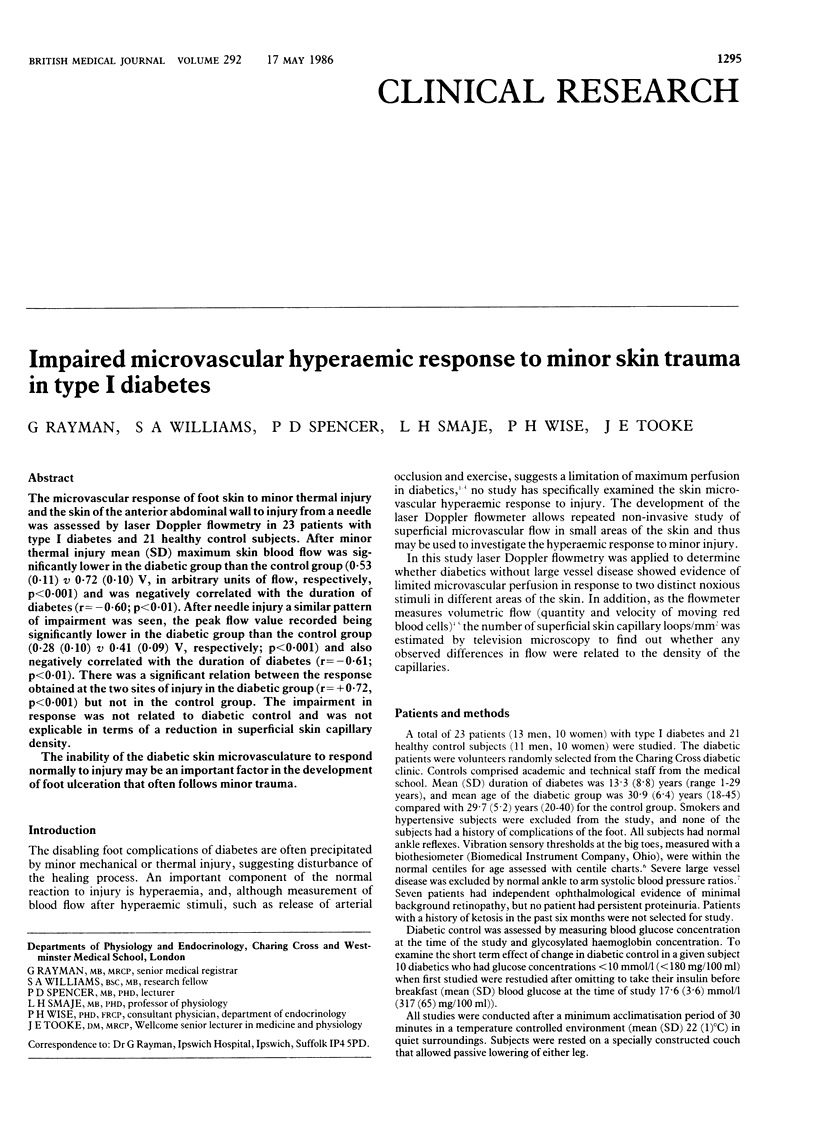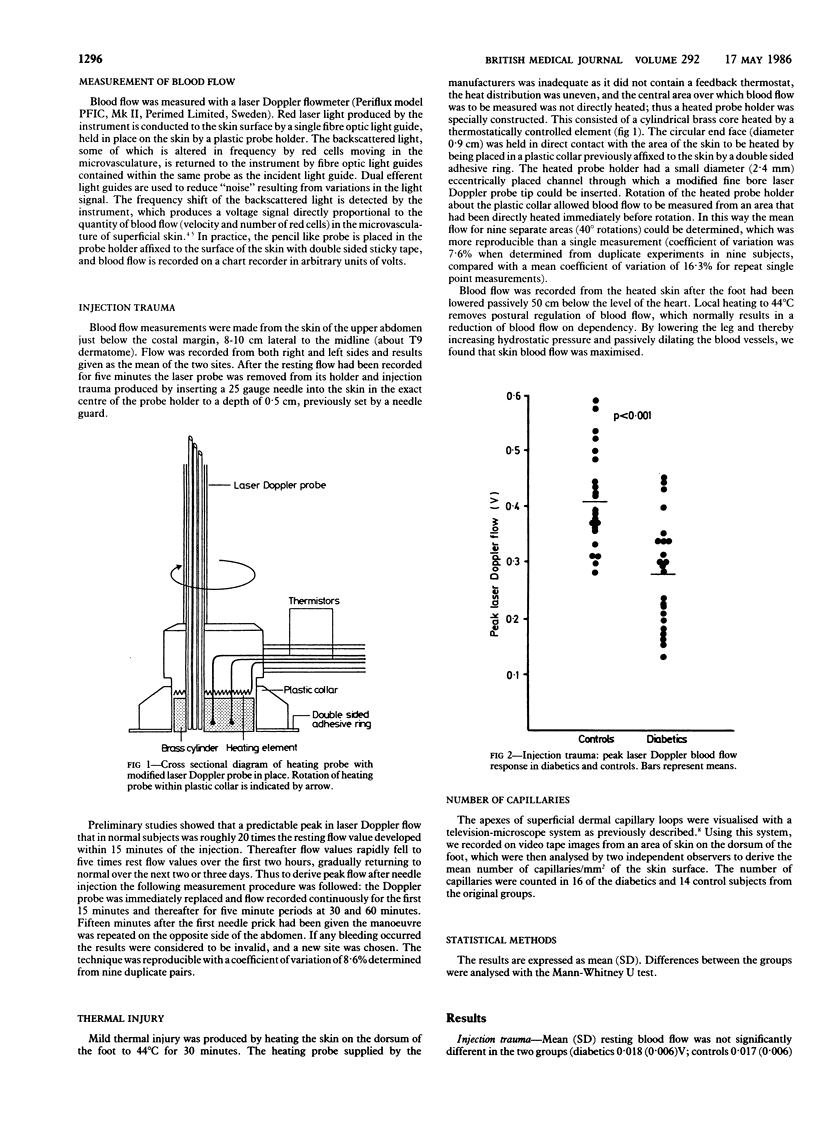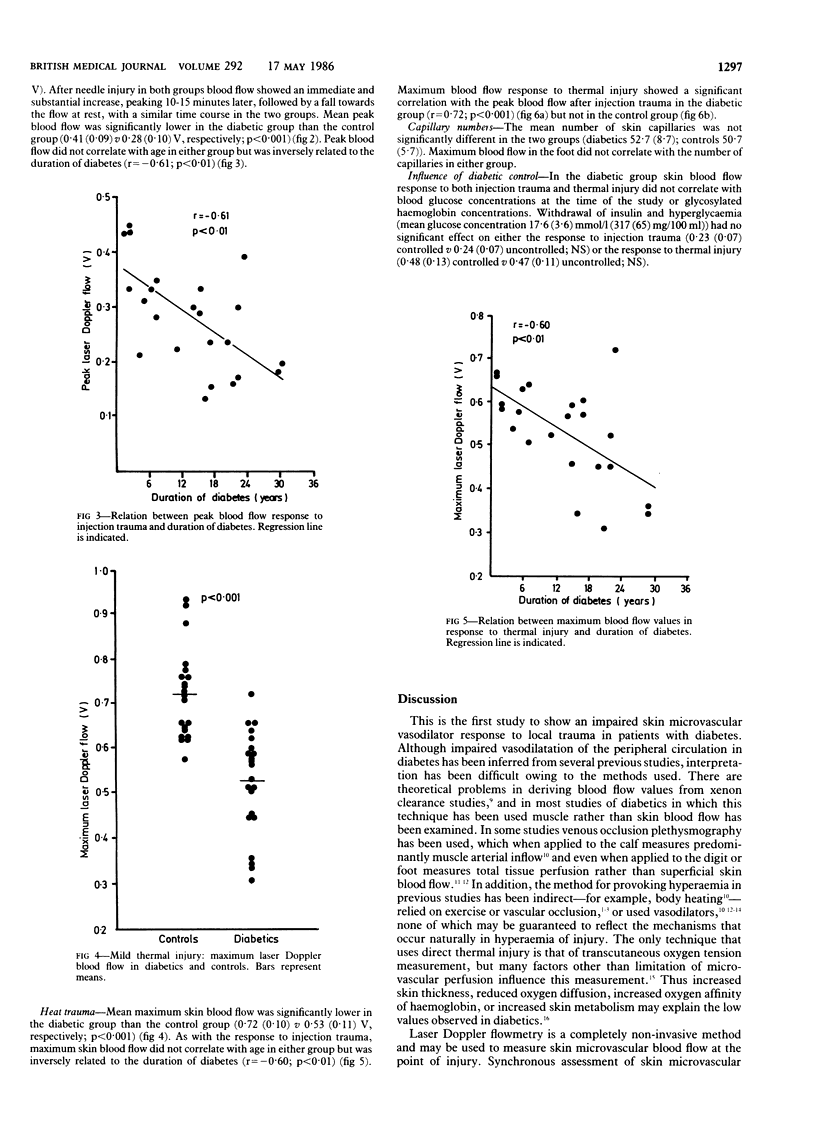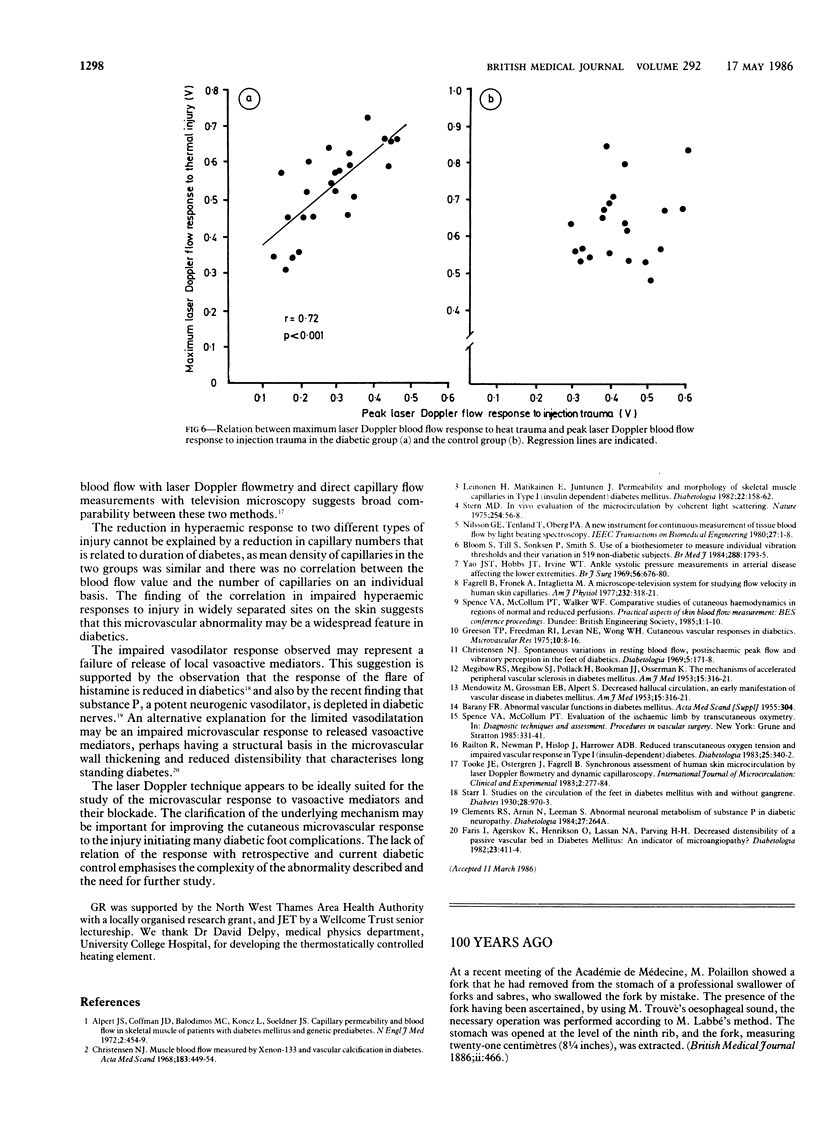Abstract
The microvascular response of foot skin to minor thermal injury and the skin of the anterior abdominal wall to injury from a needle was assessed by laser Doppler flowmetry in 23 patients with type I diabetes and 21 healthy control subjects. After minor thermal injury mean (SD) maximum skin blood flow was significantly lower in the diabetic group than the control group (0.53 (0.11) v 0.72 (0.10) V, in arbitrary units of flow, respectively, p less than 0.001) and was negatively correlated with the duration of diabetes (r = -0.60; p less than 0.01). After needle injury a similar pattern of impairment was seen, the peak flow value recorded being significantly lower in the diabetic group than the control group (0.28 (0.10) v 0.41 (0.09) V, respectively; p less than 0.001) and also negatively correlated with the duration of diabetes (r = -0.61; p less than 0.01). There was a significant relation between the response obtained at the two sites of injury in the diabetic group (r = +0.72, p less than 0.001) but not in the control group. The impairment in response was not related to diabetic control and was not explicable in terms of a reduction in superficial skin capillary density. The inability of the diabetic skin microvasculature to respond normally to injury may be an important factor in the development of foot ulceration that often follows minor trauma.
Full text
PDF



Selected References
These references are in PubMed. This may not be the complete list of references from this article.
- Alpert J. S., Coffman J. D., Balodimos M. C., Koncz L., Soeldner J. S. Capillary permeability and blood flow in skeletal muscle of patients with diabetes mellitus and genetic prediabetes. N Engl J Med. 1972 Mar 2;286(9):454–460. doi: 10.1056/NEJM197203022860903. [DOI] [PubMed] [Google Scholar]
- Bloom S., Till S., Sönksen P., Smith S. Use of a biothesiometer to measure individual vibration thresholds and their variation in 519 non-diabetic subjects. Br Med J (Clin Res Ed) 1984 Jun 16;288(6433):1793–1795. doi: 10.1136/bmj.288.6433.1793. [DOI] [PMC free article] [PubMed] [Google Scholar]
- Christensen N. J. Muscle blood flow, measured by and vascular calcifications in diabetics. Acta Med Scand. 1968 May;183(5):449–454. doi: 10.1111/j.0954-6820.1968.tb10506.x. [DOI] [PubMed] [Google Scholar]
- Christensen N. J. Spontaneous variations in resting blood flow, postischaemic peak flow and vibratory perception in the feet of diabetics. Diabetologia. 1969 Jun;5(3):171–178. doi: 10.1007/BF01213675. [DOI] [PubMed] [Google Scholar]
- Faris I., Agerskov K., Henrikson O., Lassen N. A., Parving H. H. Decreased distensibility of a passive vascular bed in diabetes mellitus: an indicator of microangiopathy? Diabetologia. 1982 Nov;23(5):411–414. doi: 10.1007/BF00260953. [DOI] [PubMed] [Google Scholar]
- Greeson T. P., Freedman R. I., Levan N. E., Wong W. H. Cutaneous vascular responses in diabetics. Microvasc Res. 1975 Jul;10(1):8–16. doi: 10.1016/0026-2862(75)90015-1. [DOI] [PubMed] [Google Scholar]
- Leinonen H., Matikainen E., Juntunen J. Permeability and morphology of skeletal muscle capillaries in type 1 (insulin-dependent) diabetes mellitus. Diabetologia. 1982 Mar;22(3):158–162. doi: 10.1007/BF00283744. [DOI] [PubMed] [Google Scholar]
- MENDLOWITZ M., GROSSMAN E. B., ALPERT S. Decreased hallucal circulation, an early manifestation of vascular disease in diabetes mellitus. Am J Med. 1953 Sep;15(3):316–321. doi: 10.1016/0002-9343(53)90085-0. [DOI] [PubMed] [Google Scholar]
- MENDLOWITZ M., GROSSMAN E. B., ALPERT S. Decreased hallucal circulation, an early manifestation of vascular disease in diabetes mellitus. Am J Med. 1953 Sep;15(3):316–321. doi: 10.1016/0002-9343(53)90085-0. [DOI] [PubMed] [Google Scholar]
- Railton R., Newman P., Hislop J., Harrower A. D. Reduced transcutaneous oxygen tension and impaired vascular response in Type 1 (insulin-dependent) diabetes. Diabetologia. 1983 Oct;25(4):340–342. doi: 10.1007/BF00253198. [DOI] [PubMed] [Google Scholar]
- Stern M. D. In vivo evaluation of microcirculation by coherent light scattering. Nature. 1975 Mar 6;254(5495):56–58. doi: 10.1038/254056a0. [DOI] [PubMed] [Google Scholar]
- Tooke J. E., Ostergren J., Fagrell B. Synchronous assessment of human skin microcirculation by laser Doppler flowmetry and dynamic capillaroscopy. Int J Microcirc Clin Exp. 1983;2(4):277–284. [PubMed] [Google Scholar]
- Yao S. T., Hobbs J. T., Irvine W. T. Ankle systolic pressure measurements in arterial disease affecting the lower extremities. Br J Surg. 1969 Sep;56(9):676–679. doi: 10.1002/bjs.1800560910. [DOI] [PubMed] [Google Scholar]


